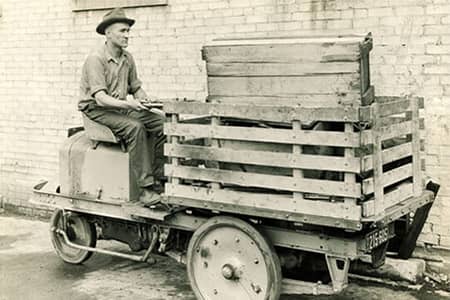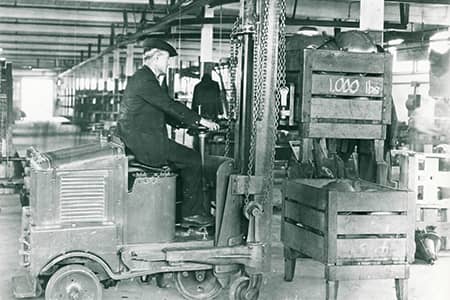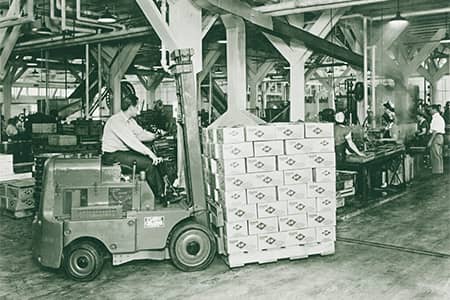Over the last century, the forklift has undergone a remarkable evolution, transforming from a basic utility vehicle to a sophisticated piece of machinery integral to modern industries. The inception of the first forklift can be traced to the Tructractor, the predecessor of CLARK forklifts. Through innovation, the Tructractor soon evolved into the forklift design we’re familiar with today, marking a significant milestone in forklift history.
1910s: Before the First Forklift, There was a Tructractor
The history of the forklift began with the creation of the CLARK Tructractor in 1917 in Buchanan, Michigan. While the Tructractor and the forklift have different configurations, the Tructractor set the stage for the invention of the first forklift. The Tructractor was the first internal combustion-powered industrial truck, originally configured with a flat bed or cargo box, to haul materials such as axles, drills, and wheels between CLARK’s various departments. Its practicality led to commercial production, with over 75 units manufactured by 1919, making a significant impact on forklift history. Today’s CLARK Material Handling Company is a direct descendant of the CLARK Tructractor Company.

1920s: The World’s First Forklift
The 1920s saw significant advancements in the Tructractor. 1922 marked the invention of the CLARK Truclift; although still not technically a forklift, it was an important step forward in forklift innovation, as it was the first internal combustion lift truck that used hydraulics instead of mechanical gears for lifting loads in a bucket. Two years later, in 1924, CLARK introduced the world’s first forklift – an internal combustion tow tractor that was modified with a tiering attachment to lift loads of lumber, freight, and other industrial materials. By 1928, CLARK made a leap forward in forklift technology by introducing the Tructier, the first forklift that used hydraulics, rather than chains and cables, to lift loads.

1930s: Mass-Produced CLARK Forklifts
In 1938, the CLARK Carloader was introduced and was the world’s first modern short-coupled internal combustion forklift truck. This design marked a significant step forward in the history of forklifts because it allowed the engine and load-carrying elements to be configured closely together, resulting in a more compact forklift, allowing for improved maneuverability in constrained spaces. Because of its utility, it was mass-produced from its inception. One year later, in 1939, the CLARK Utilitruc was introduced as the world’s first heavy-duty internal combustion forklift, used primarily in the metal fabrication and stevedoring industries. Both the Carloader and Utilitruc remained in production until 1964, contributing to the rich forklift history.

1940s: CLARK and Forklift are Synonymous
CLARK introduced the first electric versions of its Carloader and Utilitruc forklifts in 1942. In 1943, CLARK introduced the first pneumatic tire forklift, the Planeloader, used on Allied air bases during WWII, as well as by truck farmers, contractors, and airlines. Throughout WWII, CLARK supplied nearly 90% of the military requirements for forklifts, making CLARK synonymous with forklifts. Other innovations during this decade include the introduction of the Trucloader in 1945, designed for operations with limited load capabilities. In 1948, CLARK revolutionized forklift technology with the Dynatork Drive, an electro-magnetic power transmission device, and expanded its global reach by opening a manufacturing plant in in Australia, further cementing its role in forklift history.
Late 20th Century: CLARK Forklift Innovations Continue
The late 20th century saw continued forklift innovation and global expansion of CLARK forklifts. CLARK expanded its operations to Germany in 1952, followed by Brazil in 1959 and Korea in 1998. During this time, CLARK was the first to standardize safety features like load backrests and overhead guards on forklifts, innovated the Hydratork fluid transmission, introduced the first dual voltage electric forklifts, and started manufacturing narrow aisle stand-up forklifts. CLARK also marked a key production milestone – the one-millionth CLARK forklift was manufactured in 1997.
2000s-Present: Ergonomics and Sustainability
Entering the 21st century, CLARK continued to innovate and expand its global presence. CLARK further established operations in Korea in 2003, followed by new headquarters in Kentucky in 2006, and a new factory in Vietnam in 2019. Key sustainability innovations include electric CLARK forklifts suitable for pneumatic tire applications, electric CLARK forklifts that feature AC technology that reduces maintenance and noise, as well as electric CLARK forklifts with a zero-turn radius steer axle for exceptional maneuverability. In 2017, CLARK celebrated a century of innovation in material handling equipment, and commemorated this milestone with a “Centennial Edition” custom paint and decal package that was standard on all C20/C35 forklifts that year.
From its inception to the modern era, the forklift has become an indispensable tool in global industry. Its evolution reflects a story of continuous improvement, adaptation, and innovation, mirroring the dynamic nature of industrial progress.



